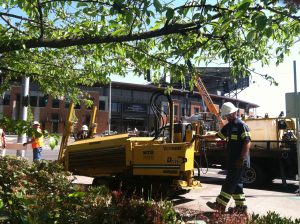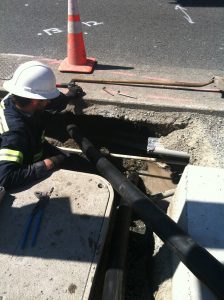HDD Reduces Traffic Impacts on Busy Thoroughfare Crossing
When the Seattle Department of Transportation decided to upgrade traffic signals on the sixth busiest street in the city, they turned to DTD to aid with the solution. Montlake Boulevard is a major arterial that passes through the heart of Seattle’s famous “U-District,” connecting State Highway 520 (which crosses Lake Washington on a new floating bridge) with the University of Washington and points north. The busy intersection of Montlake and Pacific is situated directly in front of the University’s Husky Stadium, a hub of student, alumni, and visitor activity.

DTD operator moves small Vermeer 7×11 drill rig into position for busy street crossing. Husky Stadium in background.
SDOT needed to install new control and power wiring for updated traffic signals to be installed at the site, replacing outdated equipment. The plan required that several conduits be run directly beneath Montlake Blvd., a four lane street with turning lanes. Complicating the installation were a 54-inch diameter water main within a few feet of the surface on one side of Montlake, and several utilities and irrigation lines paralleling the opposite side of the street. The soil underlying the street was known to be fill, but the composition was unknown.

Pulling back second 3-inch conduit through a maze of existing buried infrastructure.
DTD mobilized a small, Vermeer 7×11 drill rig and a small truck-mounted mud system, which were set up in a landscaped area adjacent to the crossing. SDOT supplied a combo vacuum truck for potholing of utilities, water supply to the rig’s mud system, and removal of returned drilling mud. Additional SDOT trucks provided traffic control lighting. Street closures were held to a minimum, and work was limited between the hours of 9:00 AM to 2:30 PM in order to avoid impacts on the rush hour commute.
Over a three-day period, DTD installed two, 3-inch conduits, each over 90 feet long. The soil, which turned out to be gravelly fill, was challenging to drill with the small rig, however the bores and subsequent pullback of conduit were completed without significant delay. DTD and SDOT potholed the water main, then threaded the narrow gap between the top of pipe and base of the adjacent curb in order to advance the crossing where needed.
A second series of five street crossings will be completed in June at a nearby location, where a similar traffic signal upgrade will be completed.